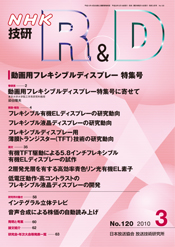
No.120 March 2010
Research Presentations
-
Fabrication of 5.8 inches Flexible Organic Light Emitting Diode Display Driven by Organic Thin Film Transistors
Yoshiki NAKAJIMA, Tatsuya TAKEI, Yoshihide FUJISAKI, Mitsunori SUZUKI, Hirohiko FUKAGAWA, Genichi MOTOMURA, Hiroto SATO, Toshihiro YAMAMOTO and Shizuo TOKITO↓summary- summary
- We fabricated a 5.8-inch flexible organic light emitting diode display driven by organic thin film transistors. The transistor array was fabricated on a plastic film with a polymeric separator for patterning of an organic semiconductor layer, and it exhibited electrical characteristics such as higher field-effect mobility and excellent spatial uniformity. We also optimized the emitting materials and layer structure of the phosphorescent organic light emitting diodes to obtain high external quantum efficiency and a low operation voltage. We improved the luminance and uniformity of the fabricated flexible display using these technologies.
-
Highly Efficient Blue Phosphorescent Organic Light Emitting Diodes with a Double-Emitting Layer Structure
Hirohiko FUKAGAWA and Shizuo TOKITO↓summary- summary
- It is necessary to improve the emission efficiency of organic light-emitting diodes (OLEDs) in order to use them in flexible displays. We succeeded in developing a highly efficient, blue phosphorescent OLED, which had previously proven to be difficult. New host materials having both high carrier transportability and large triplet energy were synthesized and were found to be applicable to efficient phosphorescent OLEDs. In addition, an extremely high external quantum efficiency of 19% was obtained by using a double-emitting-layer structure. These results imply that these new host materials and device structure can dramatically improve the emission efficiency of blue phosphorescent OLEDs.
-
Development of flexible liquid crystal displays with low-voltage operation and high-contrast property
Hideo FUJIKAKE and Hiroto SATO↓summary- summary
- For the purpose of realizing flexible large-area liquid crystal displays with high image quality, we have been researching composite films of liquid crystal and polymers supporting two flexible plastic substrates. The use of a fast-response liquid crystal material enables a high-quality moving image display. Low voltage operation for active matrix driving is achieved by forming rigid low-amount polymers in the device. Moreover, by controlling the liquid crystal component in the composite film, we can reduce liquid crystal alignment defects and obtain an excellent black level for high contrast. An A4-sized flexible color moving-image display driven by an outer transistor matrix circuit and operating with the field sequential color method was fabricated with the new liquid crystal composite film, high-precision pixel-electrode formation technologies, and a flexible backlight composed of light-guide film with small light-emitting diodes.

